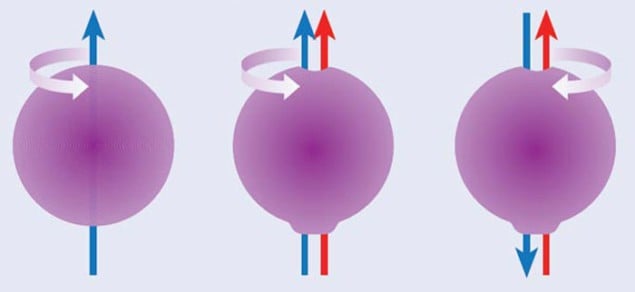
Physicists in the US and Canada have put the smallest limit yet on the size of the electric dipole moment (EDM) of the electron. By making precise measurements on a slow-moving beam of thorium-oxide molecules, the team has shown that the electron EDM is at most one-12th of the previous upper limit set by a different experiment in 2011. Constraining the value of the EDM provides important information to those developing new theories of particle physics such as supersymmetry, whereas actually measuring a non-zero EDM would be a major breakthrough in physics.
The simplest take on the Standard Model prohibits the electron from having a permanent EDM. This is because the combination of an EDM with the electron’s well-known spin magnetic moment would violate time-reversal symmetry, which says that physical interactions should look the same if the direction of the flow of time is reversed (see figure “Incompatible moments”). While more-sophisticated versions of the Standard Model do allow for an EDM, they nevertheless suggest it would be much too small to measure in the lab. However, theories of physics that go beyond the Standard Model – such as those invoking supersymmetry – do predict much larger values of the EDM that could be determined experimentally.
In 2011 Jony Hudson and colleagues at Imperial College London found the EDM to be less than 10.5 × 10–28 e cm. While this is still much larger than the upper limit allowed by the Standard Model (about 10–39 e cm), it does begin to rule out certain theories that go beyond the Standard Model (see figure “Less room for new physics”).
Shrinking EDM
Now, physicists working on the Advanced Cold Molecule EDM Experiment (ACME) in the US have improved on this limit by a factor of 12, setting the upper limit on the EDM at 8.7 × 10–29 e cm. ACME is a collaboration of physicists at several universities in the US and Canada – with the main players at Yale and Harvard.
The experiment begins by creating a relatively slow-moving pulse of very cold thorium-oxide (ThO) molecules, which is sent through a region where parallel electric and magnetic fields run perpendicular to the beam. Laser pulses are used to put the molecules into specific states in which the spin magnetic moment of an excited electron (and its EDM, if it has one) is perpendicular to the applied fields. The molecules then travel about 22 cm through the parallel fields, causing the spins (and EDMs) to rotate about the field direction. This precession angle is then measured precisely using a spectroscopic technique.

If the electron has an EDM, its presence will contribute to the precession angle by an amount proportional to the electric field in the region of the electron. This is where the ACME team uses a clever trick. ThO is a polar molecule that has an extremely large electric dipole moment. This creates a huge “effective electric field” in the vicinity of the electron – much larger than could be applied externally in the lab. The molecules are prepared such that the effective electric field is either parallel or antiparallel to the applied fields. These configurations shift the precession angle in opposite directions. By measuring the difference in the precession angle between both of these configurations, the team is able to determine the EDM.
“Significant step forward”
The ACME experiment measured the EDM to be zero to within very small experimental uncertainties. As a result, it was able to put the most stringent upper limit on its value so far: 8.7 × 10–29 e cm with a 90% confidence. “This is a significant step forward, the biggest improvement in EDM measurements in a decade or so, and the researchers haven’t exhausted the potential of the system,” says Chad Orzel of Union College in the US, who was not involved in the research.
Orzel points out that the measurement is the first result to come from ACME and he believes that the team will be able to improve on it. “This is basically the first real run of the experiment, and people can always find ways to improve the initial systematic uncertainties,” he says. Indeed, Orzel believes that the team should be able to improve its initial result by an order of magnitude.
On a par with the LHC
Time-reversal symmetry is related to another important symmetry of physics: charge–parity (CP) symmetry. As a result, measurements of the electron EDM also provide a constraint on CP violation, which occurs in many physics theories that go beyond the Standard Model. Testing these models is the current focus of particle-physics experiments around the world, including those at the Large Hadron Collider (LHC) at CERN. The ACME team says that its experiment has constrained CP violation at energies on a par with those accessible at the LHC.
Orzel says that some of ACME’s success can be attributed to the fact that it is a collaboration of three leading atomic-physics groups, headed by David DeMille at Yale, John Doyle at Harvard, and Gerald Gabrielse at Harvard. “ACME has really only been going for something like three to four years, and they’ve already produced a great measurement,” Orzel says. “This shows something of the power of the ‘particle physics’ sort of model they’re using, combining several high-power groups together in a bigger collaboration than you usually see in [atomic, molecular and optical] physics, so as to bring greater resources to bear on the problem.”
The research is described in a preprint on arXiv.
- Find out much more about the search for the electron EDM in the article “Measuring (almost) zero” by Chad Orzel.



